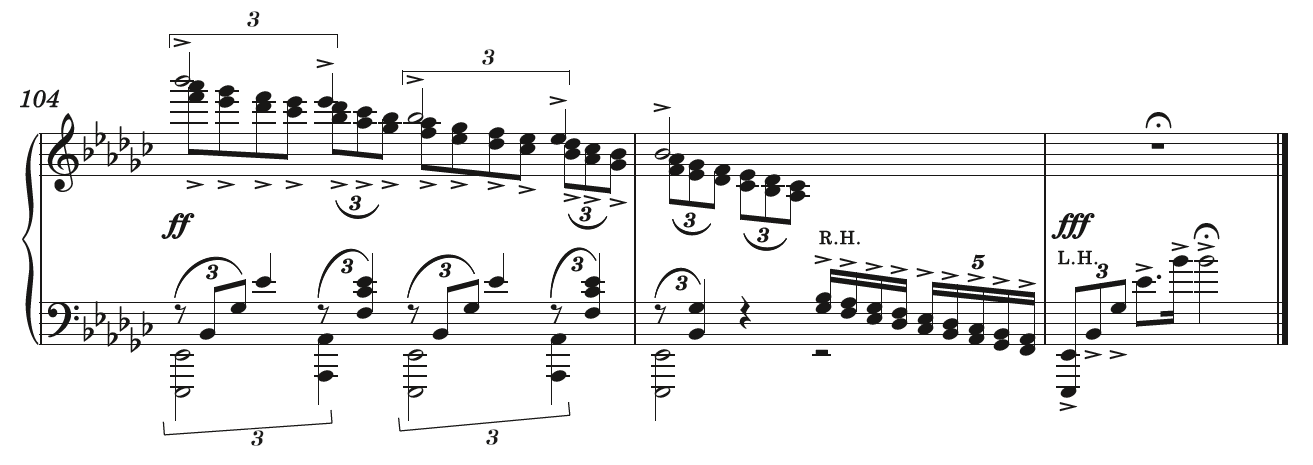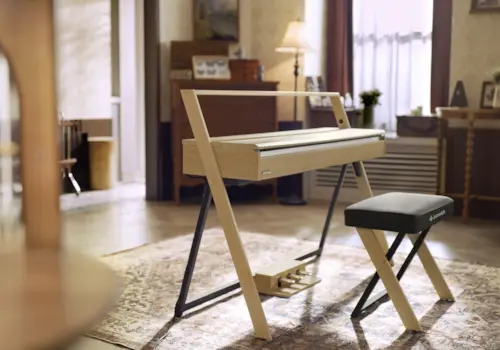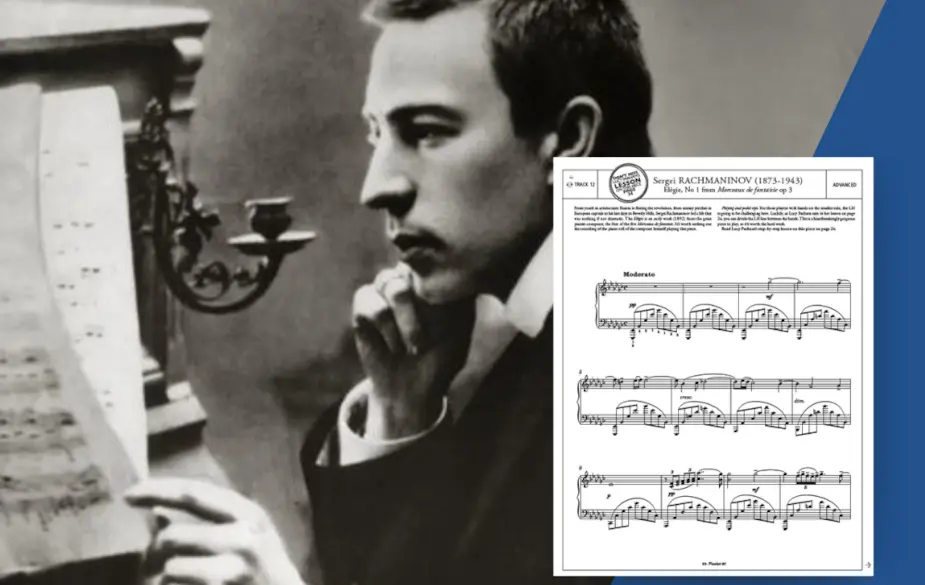Rachmaninov had big hands, but if you don’t, you can still master one of his most hauntingly gorgeous works by following the guidance of concert pianist and teacher Lucy Parham

Don't have the score? You can download the full piece from our Scores store, here.
Rachmaninov was one of the last great composer-pianists. He was often shunned for being a true Romantic and not being forward-thinking, but his music has stood the test of time. Before Rachmaninov was exiled from his native Russia in 1917, he had already completed a substantial amount of piano music. Elégie comes from Morceaux de fantaisie Op 3, a set of five pieces dating from 1892 that also includes the famous C sharp minor Prelude. Like the subsequent set of six pieces Op 10, the Op 3 set was clearly influenced by Chopin, a composer whom Rachmaninov admired greatly.
A real sense of pathos runs through this hauntingly beautiful piece. Pathos is an emotion that we find at the heart of most of Rachmaninov’s compositions. He never really recovered from having to leave his homeland, and consequently much of his music is filled with a sense of longing. However, a performer should avoid confusing this pathos with sentimentality or a false sense of over-romanticism, which is all too easy to fall into when you play this lush and beautiful music.
TIP 1: Learn the left hand first!
When you begin to read through the Elégie you will immediately notice the parallels between it and Chopin’s Nocturnes. This is particularly apparent in the left hand (LH), over which the right hand (RH) sings the most glorious melody. As with Chopin’s Nocturnes, it is very important to master the LH first. Along with learning the climax (bars 63-82), my top tip is to learn the LH alone first. You can even try singing the RH over the top of your LH playing!
The large hand span required to play the LH in this piece can be problematic for many pianists. We know Rachmaninov had a huge hand span, so he obviously had no trouble playing this. Luckily for those not so gifted, there are many ways to divide the LH. I would play it in one hand as printed in the Pianist score, but I can see the benefits of dividing it between two hands if you have a smaller hand span. The choices for the smaller hand are either to take the top note (Bb) in the right hand with a third finger, or you can take the first three notes in the LH and the subsequent two in the RH (Eb and Bb) with a thumb and third finger respectively.
Even if you choose to play all of this in the LH as written, as the piece progresses you will find that there are still many notes that are easier to pop into the RH. I will point some of these out, but many will be obvious to you – and everyone is, of course, different.
TIP 2: Keep up the pace
I want to talk a little about the tempo of the Elégie. If you listen to Rachmaninov’s own recording, you will notice that he takes his marking of Moderato very seriously. If you listen to a lot of other recordings, you will hear that some people play this piece extremely slowly. In my view, I think playing slowly is a mistake, as the line needs to continue and flow throughout. It is not marked Lento. A sense of direction is required at all times.
TIP 3: A real sense of balance is needed in the opening
Technically speaking, your LH should wrap around the keys like a glove in this piece. The fingertips need to be a bit flatter, and although the opening marking is pp you still need to have a level of projection. This requires the fingertips to really sink into the bottom of the key bed. Note how when the melody in bar 3 enters, the first note in the RH is weighted with an accent and it is also mf. Immediately Rachmaninov is requiring you to project the tone of the melody while keeping the LH much quieter. A real sense of balance is needed.
Personally, I would think about putting the fifth LH semiquaver of bar 4 (Ab) into the RH with a thumb. Observe the notes in the melody where Rachmaninov writes an accent over the note – this is for extra weight and should not be forced. Crescendo through bar 6 and subsequently tail off from bar 8 to bar 9.

Bars 3-4
Bar 9 is a beautiful interrupted cadence and requires a special colour. It is followed by an echo at bar 10. Try to ensure that the RH triplets here are smooth and not lumpy!
There is a second statement of the main theme at bar 11. This time it is a little more embellished, but keep a sense of improvisation and do not make it too ‘square’. This phrase is heading towards bar 15, where we have the first climax of the piece. In these bars it is important that you also use the LH to help you, because the crescendo cannot be reached alone just with the RH. At bar 18 try to grade the sound in a perfect diminuendo into the relative major of G flat major. Resist any urge to slow the tempo down, as the line must continue.
TIP 4: A lyrical and persuasive tone is needed
At bars 17, 19, 21 and 23, it is possible to take the first three (LH) notes in the LH and the subsequent five notes in the RH. Or, of course you can play it exactly as it is written. The marking ‘con affeto’ at bar 22 means ‘with affection’ and requires a more lyrical and persuasive tone. Try to make these phrases longer – at least in four-bar phrases, and not a long sequence of two-bar phrases. The line is crucial and you are heading towards the climax at bar 26. I suggest that you practise the LH alone through this climactic phrase, as there are quite a lot of leaps in the LH and you need to be exactly sure where you are going. Notice the inner line in the LH from bars 26-30; the fifth quaver is another melodic line in itself. Lean into these notes and make sure they really speak.
Keep up the tone and the tension when you arrive at bars 33-34. Continue with this to the end of the phrase at bar 40. I must also mention the semiquavers in the RH (in sixths) in the bar 34. These can be tricky and I would suggest breaking them down top to lower. This means you play the F followed by the Ab then the Gb followed by the Bb etc. Try to keep the hand supple here, as a static wrist will make the passage difficult.

Bars 33-34
TIP 5: Break down the RH in order to nail the middle section
Your main challenge when you arrive at the central section marked ‘piu vivo’ is to decide how much you should move on the tempo. I believe it is important to know what tempo you would like to play the climax of the piece (i.e. around bars 64-70). Of course, you want this to sound grand and maestoso, and not rushed – therefore, if you start the ‘piu vivo’ too quickly you will not have anything left!
The RH can be technically quite tricky at this point. Again, I would recommend the practice of ‘breaking down’ from the upper to lower part of the RH. This means you will play Eb followed by Bb, then Db followed by Gb, and so on.

Bars 65-68
You might also try playing the top part alone (5-4-5-4) followed by the lower part (2-1-2-1). You can build this up by adding this over the LH one part at a time. In the LH melody Rachmaninov employs a beautiful rising sixth. This needs to be very expressive and played with real depth into the bottom of the key. Make sure that you know your LH well because your focus will ultimately need to be deployed on to your RH. See if you can play that LH melody with your eyes shut!
Notice the dynamic markings here. The LH is mf and the RH is pp. Knowing this gives you a great insight into the balance required between the two hands. A note for the memory is the difference between bar 46 and bar 52. When you reach bar 52 you want to ease back a little into bar 53. This is just a gentle and short rit. And then, out of this beautiful G flat major gentleness comes a top Bb in the RH marked mezzo forte. This note needs to ring with a real clarity. It is the first time we have had a melody note in the RH in this section.

TIP 6: Project!
Over the next few bars it is extremely important to focus on getting over the bar line. The RH needs to have a beautiful overlapping cantabile (right to the bottom of the key). Project as if you were playing to the back of the concert hall. When you arrive at bar 63, drop the tone right down to pp.

Bars 63-64
This is now a long sweep up to the climax, and you have many bars in which to make your crescendo. Here is another place where I would advise learning the LH alone, so that you can play it with your eyes closed. There are a few nasty leaps here in the LH too, so it is worth spending a lot of time on. At bar 70 the LH is also as important as the RH. Make sure the subsequent RH crotchets in bar 71 are really accented, not in a violent way but in a projected and strong way. Note the accents on the left hand Eb bass note in bar 72 and bar 75.
TIP 7: Allow the melody to 'ring like bells'
This climax is long and persistent. and therefore it is vital you keep the tone at bar 73 right through to bar 82. The following bar is almost like a little cadenza. Take your time and lift the pedal slowly so that the rests are fully audible. The last two notes should melt into the return of the theme at bar 84. These next couple of lines are a direct repeat of bars 33 to 40. But, at bar 90 the chord changes to the most sublime ppp chord. Try to make a very special colour here and voice your top finger in that traditional Russian manner, focusing on the top finger’s weight.
Some of the accompanying LH notes are best shared between the hands. For instance, you may want to take the fifth and sixth quavers of bar 95 in the RH. Notice the mf marking in this bar too. See how the melody climbs between bars 99 and 101 and then the top of the phrase at bar 104 into bar 105. Again, try to forget that there are bar lines and sweep over at the bar. The climax at bar 105 needs a very strong bass and the RH should almost be ‘torn’ out of the piano.

Bars 105-end
At bar 105 you’ll see that the very top notes are Bb, Eb, Bb, and so on. These need to ring like bells; something that Rachmaninov was obsessed with his entire life. The Elégie ends with a declamatory phrase that is powerful and creates the perfect sense of finality.
This article is taken from Pianist 87, available here.








